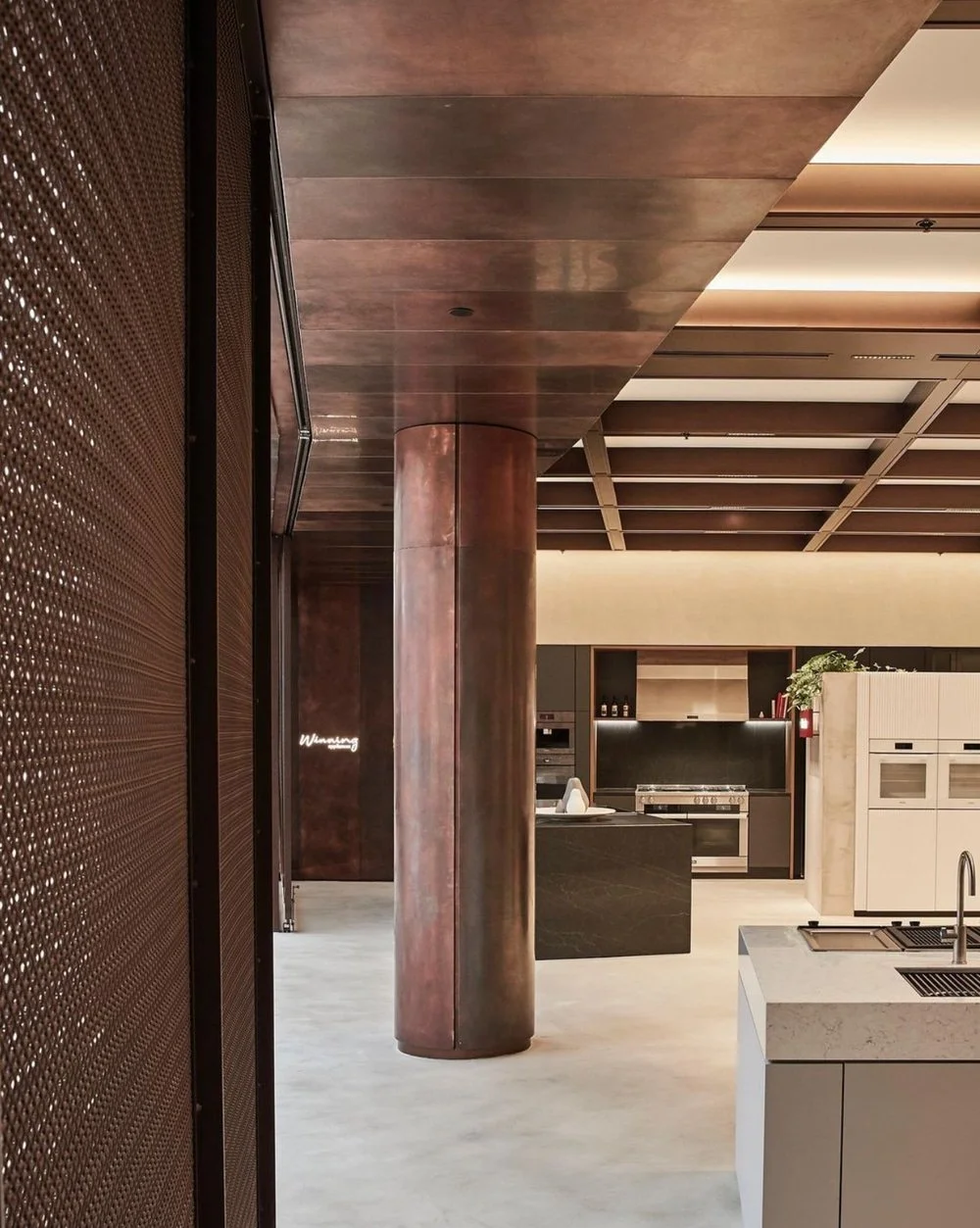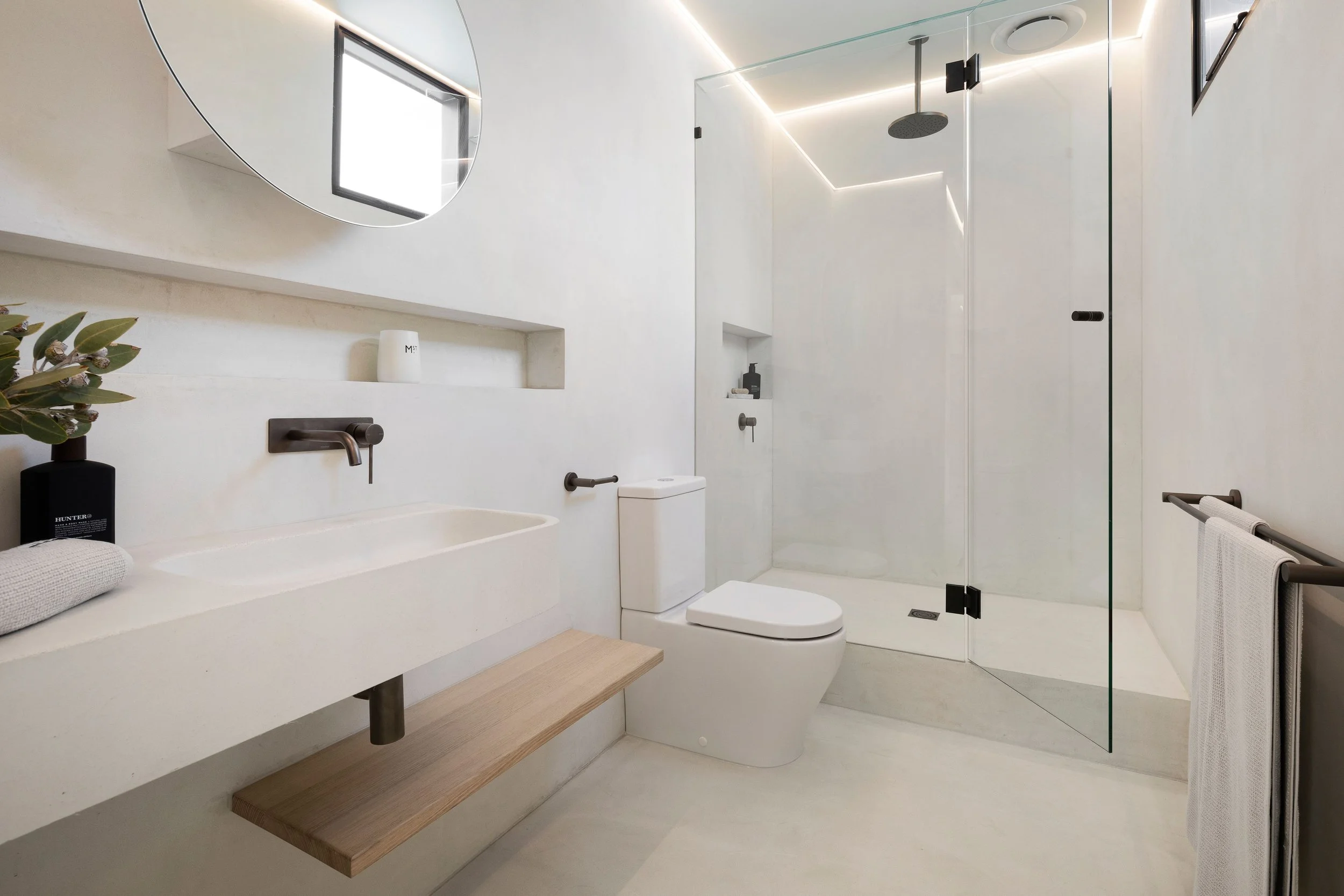The Pros & Cons of Microcement Flooring
Updated for November 2025
If you’re doing some research on microcement before an upcoming project, this honest assessment of its pros and cons might help. In 2025, we celebrated 26 years of microcement installations at Alt. Surfaces, so rest assured our team is qualified to give advice in this department!
One of microcement’s biggest appeals is its similarity in appearance to concrete, while offering greater flexibility in terms of applications and customisable design options. It doesn’t have many downsides, but there are some potential challenges to keep in mind before proceeding with your project.
In this blog post, we’ll explore the reasons why microcement is one of the most popular flooring choices, and also examine some potential hurdles.
Ultimately, our aim is to put your mind at ease and prove that microcement is one of the best flooring options for contemporary spaces — as proven by thousands of clients around Australia.
Read More: The Reasons Microcement Flooring is Trending
What is Microcement Flooring?
Microcement (also called microtopping, microscreed, and micro concrete) is a versatile contemporary flooring solution known as an overlay. This means it can be applied on top of existing hard surfaces, most commonly for concrete resurfacing — but it’s also just as popular for resurfacing tiles, MDF, and slate.
Made from a mix of cement and adhesive polymers, microcement is applied by hand as one continuous floor coating 2-3mm in thickness. It can also be applied to walls, ceilings, joinery, pools and more.
Common areas of application internally include the living room, dining area, kitchens, bathrooms (including showers and baths), bedrooms, and joinery. Read More: The What, Where, How & Why of Microcement Bathrooms
Microcement is also suitable for outdoor flooring, such as garden pathways and pool surrounds. Read More: The Best Outdoor Flooring For Uneven Surfaces
Pros: The Advantages of Microcement Flooring
Aesthetic appeal
Microcement is applied by hand as one continuous coating. This is good news if you’re after seamless flooring. Additionally, X-Bond Microcement comes in four different finishes and a range of shades — with the possibility to create custom colours. This gives you the freedom to choose textures and colourways that suit any interior design story.
Applied over a wide range of existing substrates
Compared to other concrete overlays, microcement can be installed over almost any existing hard surface with X-Bond’s Remodel Without Removal method. This means you don’t need to demolish an existing floor to install new microcement. The surfaces you can apply microcement on:
Floors: Concrete, Tiles, Compressed Sheeting, Hebel, Underfloor Heating
Walls: Plaster, Villaboard, Blue Board, Concrete, Ply, WR Board, Tiles
Joinery: MDF, Marine Ply, Compressed Sheeting, Laminate
Note that microcement is compatible with underfloor heating, making it a practical flooring option for home interiors.
Versatile hand-application
Because microcements like X-Bond are hand-installed with a trowel at a minimal thickness, they allow more intricate applications. This is a huge benefit if you want to use microcement for other surfaces as well as your flooring. Maybe you have visions of a grand curved staircase, bespoke microcement joinery, or wall niches inspired by Sculpt Adelaide.
Durability and resilience
Don’t be fooled by the minimal thickness — microcement overlay systems are just as durable and practical as other hard surfaces like concrete.
X-Bond is particularly resilient because it contains added latex polymer, giving the surface more flexibility to prevent cracks, and a high resistance to de-lamination (in fact, we’ve never had a de-lamination issue with any of our installations in 25 years!).
We also install X-Bond with a waterproofing membrane in wet areas. As well as providing a waterproofing barrier, Liquid Membrane boasts long-term anti-fracture benefits and can also bridge cracks in the existing substrate. This means you can install microcement flooring on top of damaged surfaces.
And that’s not all: microcement is resistant to stains and mould, too. This is because we’ll always finish it with a few coats of a high-grade sealer.
Easy maintenance
It’s probably the most commonly asked question; is microcement easy to clean?
The answer is yes, especially in the bathroom. Because it’s applied as a seamless coating, microcement is grout-free. This means no more scrubbing soap build-up in shower tiles and saying goodbye to expensive products. Water, neutral soap, and a cloth are all you need to clean microcement.
Its easy maintenance also makes microcement a popular flooring choice in retail, hospitality, and commercial projects with high foot traffic.
These are our recommendations for microcement maintenance:
Avoid letting puddles sit on the surface for too long
Ensure your installer uses a high-graede sealer
For a polished shine, carry out regular maintenance on microcement flooring using acrylic waxes
Try not to carry sand or small stones inside from your shoes
Use chopping boards for microcement kitchen countertops
Cons: The Challenges of Microcement Flooring
Professional installation is required
Microcement is not a DIY solution, especially if you want the best results. Some of the advantages above are dependant on correct installation — and microcement installation is not beginner-friendly. Worldwide, X-Bond is only installed by trained professionals to ensure the highest quality and longevity.
If you’re looking for a microcement installer in Melbourne or the Mornington Peninsula, contact us. If you’re based interstate, our suppliers Seamless Overlays train a growing network of Australian microcement installers.
Product quality matters
The quality of your job depends on the quality of the microcement itself. Due to its growing popularity, there are many microcements on the market — but it’s hard to find one in Australia with a history like X-Bond.
Decades of experience have guided the development of the X-Bond Microcement overlay system, which we’ve been installing since 1999. It’s one of the oldest microcements on the Australian market with 25 years of case studies.
Cost considerations
In many ways, a flooring overlay is already saving you money as it cuts out the costs of demolition. For example, there’s no need to rip out old tiles before resurfacing your shower with microcement.
We can’t give exact price estimates as every installer will quote jobs on an individual basis. However, there are some projects where additional costs are required. Damaged substrates will need extra preparation before the microcement can be installed.
It’s also worth keeping in mind that microcement does become more expensive per square metre as the area of application gets smaller. Read more about this in our guide to microcement pricing.
The result is only as good as the substrate it’s applied over
If your existing surface is unstable, movement can transfer through to your overlay. This is what can cause cracks in the microcement.
To avoid future damage, your installer may be required to stabilise the existing flooring for added security before resurfacing with microcement. This is why you’ll want to engage a professional for your installation.
You might be able to notice repairs
In the event that your microcement flooring is damaged, it can be patched. However, since the original coating is applied as one continuous layer, a repair layer can sometimes be visible. Installers will try their best to make repairs blend in as seamlessly as possible. For some X-Bond finishes this is not as noticeable, especially where the trowel marks already create tonal variations.
In general, this isn’t a huge concern. A high-quality microcement shouldn’t damage easily, as long as you take good care of it!
Case Studies
Here are some examples of microcement flooring installations:
Comparisons
Microcement or Tiles?
There are a few reasons you might prefer microcement over tiles.
Tile floors are more vulnerable to stains and mould because of dirt build-up in the grout lines. Water can even permeate into these joints over time.
It’s also more likely that tiles will crack under intense pressure — i.e. the refrigerator — or when dropping items onto the floor.
Summary: Choose microcement if you want a seamless grout-free surface that’s more resilient to pressure, leaks, and grime.
Microcement or Concrete?
Microcement flooring can be applied on top of almost any existing hard substrate without the need for demolition and machinery. Concrete, on the other hand, has stricter requirements for installation.
Microcement is also a lot thinner than concrete, but has the same structural integrity and resistance to cracks. The minimal thickness ultimately makes it a more versatile surface product than concrete. We’ve installed X-Bond microcement on: floors, walls, ceilings, pools, stairs, coffee tables, basins, desks, and joinery.
Summary: While there’s nothing wrong with the real thing, a concrete overlay system might be a better fit if you’re looking to remodel or are seeking greater versatility.
Read More: Microcement vs. Concrete: What’s The Difference?
Microcement or Epoxy Flooring?
An epoxy floor is made with resin for a shiny, almost plastic-looking effect. A microcement coating is more tactile and ‘natural’, much closer in appearance to real concrete. You can also pick from various textures.
Bear in mind that expoxy resin flooring can also turn yellow, whereas microcement’s colour won’t undergo any change over time.
Summary: Choose microcement if you want a more natural concrete-looking finish that won’t discolour over time.
FAQ
-
Microcement is a naturally slip resistant surface due to the visible appearance and texture of the trowel marks. However, we do have a specialised finish for external flooring requiring greater slip resistance: X-Bond Blade is installed with a blade tool to create additional non-slip chatter marks.
-
Microcement is as reliable as the substrate underneath. If the subfloor is already cracked, then this can transfer through to the microcement overlay. This is considered substrate failure beyond our control. This is why substrate preparation is crucial; and why flooring that is subjected to significant movement is not a recommended substrate for microcement.
-
When installed correctly, and if choosing a premium product, microcement lasts for decades. It’s a highly durable surface coating, resistant to wear & tear, abrasions, stains, and UV. This is why it’s commonly specified on high-traffic flooring.
Conclusion
In a nutshell, microcement is our recommended flooring solution if you are:
Seeking alternatives to concrete but love the seamless joint-free aesthetic
Interested in customisable texture and colour options
Resurfacing an existing substrate
Looking for a durable floor that’s also easy to maintain
The bottom line is that microcement’s benefits are vast, while the cons are few and far between — not to mention easy to work around with knowledgable installers and a quality product.
So, as you start planning your flooring project, contact Alternative Surfaces for more information on specifying X-Bond.







